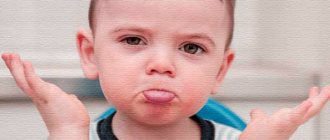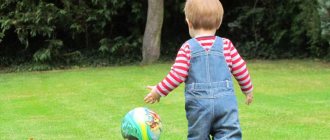Development norms
Doctors have approved certain age limits for each child’s skill. But it is worth considering that they are all approximate, that is, deviations from them are quite acceptable.
According to modern psychologists, at one and a half years old children should:
- actively move (get up, walk, fall, try to climb everywhere);
- play “okay”;
- be able to clench your fist;
- clap your hands if something works;
- play with household objects (pots, ladle, spoons, etc.);
- repeat simple everyday actions (combing yourself, your parents or toys, rolling cars or a stroller on the floor, etc.);
- understand requests (it is not necessary to fulfill them correctly);
- respond to the name (provided that he hears it at home when addressed to himself);
- do one thing for no more than 10 minutes;
- point to an item that aroused interest;
- put rings on the pyramid (their order does not matter);
- make rhythmic movements to music;
- digging through clothes, taking them out of closets and drawers;
- cry if what is happening does not suit him;
- throw objects and be happy about it.
Healthy children between one and two years old do at least half of this list. Speech is not an indicator of a child’s development during this period of time. Although you can still hear from old-school neurologists about 20 words that a baby should pronounce.
Neurologists call a “word” any syllable or vowel that denotes an object (mu is a word, ma is also a word).
By the age of two, recognizable meaningful words should appear. But even if this does not happen, another 3-6 months are given to monitor the child. Next, they look at other development indicators and decide whether to wait until they are 3 years old or start classes with a speech therapist. Thus, a child of one and a half years may not speak a single word that adults can understand. And this will be considered a variant of the norm.
Treatment of children with delayed speech development, how to treat children with speech disorders
Fortunately, Sarklinik has treated hundreds of children with delays in speech, psycho-speech, mental, motor, and psychomotor development. Treatment of alalia, treatment of dyslalia, treatment of general speech underdevelopment, treatment of dysgraphia, treatment of acalculia, treatment of encopresis, treatment of perinatal encephalopathy, treatment of tone disorders, treatment of akataphasia, treatment of akatagraphy, treatment of intracranial hypertension syndrome, treatment of dyslexia, treatment of autism, treatment of cerebral palsy, treatment are provided. enuresis, treatment of minimal cerebral dysfunction in Russia, in the Saratov region, in Saratov. Sarklinik knows how to teach a child to speak, how to treat and cure a child, how to treat delayed speech development in a child , how to treat delayed psycho-speech development in children, how to cure delayed neuropsychological development, how to give impetus to speech development, how to replenish vocabulary, how improve speech. Treatment methods have proven themselves over the years. Severe, moderate, and mild delays in psycho-speech development, and mental retardation are treated. Sarclinic works with serious diagnoses, when parents have less and less hope for recovery. Unfortunately, in such cases, as a rule, multiple courses of complex treatment are required, as a result of which memory, thinking, speech, mental development, motor sphere, and motor activity are improved. There is extensive experience in treating children with pediatric pathologies aged from 3 months to 17 years. There are plans to publish a video course “ How to teach a child to speak ?” On the medical website sarclinic.ru you can ask a doctor a question online for free and read patient reviews. Help your child right now!
There are contraindications.
Specialist consultation is required. Sign up for a consultation .
Text: ® SARCLINIC | Sarclinic.com \ Sarlinic.ru Photo: (©) Hyrman | Dreamstime.com \ Dreamstock.ru The child depicted in the photo is a model, does not suffer from the diseases described and/or all similarities are excluded.
Related posts:
Children's nocturnal enuresis: treatment, causes, how to treat in Russia, Saratov
Nocturnal enuresis, sleep enuresis, bedwetting, treatment, enuresis in children, in adults
Where and how to buy an enuresis, urinary alarm clock?
A child stains his panties with feces, what to do if he smears it in his panties, the child’s panties are dirty
Why does a child feel bad, doesn’t speak much, doesn’t speak, how to teach a child to speak, talk
Comments ()
Reasons for the lag
Many factors influence a child’s speech development.
They are divided into several groups:
- organic (diseases of the nervous system, inner and middle ear, traumatic brain injuries, prematurity, hypoxia and injuries during childbirth, bad habits of the mother and extragenital pathologies of the pregnant woman);
- physiological (early cessation of breastfeeding, delayed transition to food in pieces, hypotonicity of the muscles of the articulatory apparatus, malocclusion);
- psychological (stress, tense family relationships);
- social (family dysfunction, lack of communication between adults and with the child, or overprotection when the motivation to speak disappears).
Most causes are reversible—they can be prevented or corrected. Organic lesions are treated by a neurologist, who can be consulted about speech. He will find out the child’s level of development and the degree of brain damage. If it is small, you can do without drugs and procedures, and pay a little more attention to classes on making sounds.
How to stimulate speech at 1.5 years old?
Various games and exercises will help develop the speech of a one and a half year old child:
- "Telephone". Into a non-working or toy phone, say words that your baby already knows, then ask him to repeat them. Focus on pronouncing words as clearly as possible with emphasis on stressed syllables. In the future, you can add words to the game that the child could hear, but cannot pronounce himself.
- "Construction". The game is more suitable for boys. Load and unload the toy dump truck with blocks or other objects, making sure your child gives the commands “up,” “down,” and “stop.”
- Communication with a doll. A more convenient game for girls. Configure the child so that he thinks that the doll dreams of hearing the baby's voice.
- "Dunno." A game for children who don't speak because they are lazy or have no reason to. One of the parents takes a toy and walks around the house with it, pronouncing on its behalf everything that comes along the way, all the time confusing the names. This must be done in front of the child. To make the game more interesting, you can set an additional condition according to which all toys that are incorrectly named by an adult and not marked by the child as incorrect names will be sent to a black bag (or any other place inaccessible to the child). Thus, the child has an incentive to return those same “lost” toys by correctly pronouncing their name.
- Games with pictures. The child needs to name the objects and animals he sees in the pictures. To increase your child's interest, you can offer him a small reward (a treat or a toy that the child likes) at the end of the game. For example, for each correctly named object, a child receives 1 cube, and he needs to collect 10 cubes (more is possible). It is better not to show the gift itself to the baby, but to hide it nearby under a scarf or towel. To complicate the task, you can ask the child to name individual parts of animals and objects shown in the pictures.
- Stimulation of fine motor skills of the hands. Plays an important role in speech development. You can conduct finger massage sessions or invite the child to sort out stones, cereals, fasten and unbutton buttons on clothes, and tie shoelaces. Other ways to develop fine motor skills can be found here.
Be extremely careful not to leave your child alone with small objects so that they do not put them in their mouth and try to inhale them.
- "Theater". Stage scenes with toys, distribute roles with your child and each speak for their characters. Don't forget to keep an eye on your child so that he doesn't lose interest.
- "Keep following me." Before starting this game, the child must be familiarized with the children's poems you have chosen. After you have read them to your baby several times, so that the child can remember the text, repeat the verse again, but at the end of the lines, become silent so that the baby can finish them himself.
More exercises and useful tips to help your child start speaking are collected in this article.
You can find many more games and exercises for speech development, but do not forget that the main thing is to do them together with your child. It is the voices of his parents, and not television, telephone and other means, that stimulate him to speak. If you are worried that your child has problems with speech development, do not be afraid to contact pediatricians or speech therapists.
Diagnosis of the condition
If parents are concerned about the lack of speech in a child of 1.5 years, they should start a diagnosis with a neurologist. He will assess the risks of organic brain damage and prescribe the necessary examination. If the patient has no pathologies of the central nervous system, then drug treatment is not required.
The next step is to visit a neuropsychologist. It determines the correspondence of mental development to age. If discrepancies are detected, the doctor gives recommendations for correction at home. It is better to contact this specialist with the whole family. Often, a child’s speech problems lie in relationships between adults, which can only be noticed from the outside.
The third stage of the search is a speech therapist. He will not take a one-and-a-half-year-old baby to classes, but he can check the articulatory maturity of the apparatus and show exercises to perform at home. After a few months, it is worth going for a second consultation to monitor the pace of the child’s development.
Principles of speech development
If a child does not speak at 1.5 years old, you should pay attention to what he does during the day.
Several points need to be included in the routine:
- Development of gross motor skills (running, climbing over obstacles, climbing stairs, swimming).
- Fine motor skills activities (playing with materials of different textures - pasta, cereals, dried beans, various fabrics and special toys with small parts).
- Talk more (parents should talk through their every action and what they do with the child).
- Eliminate gadgets and cartoons (they create passivity in speech - they teach you to listen, but not speak).
- Sing songs (especially favorite ones that the child knows and will try to repeat).
- Encourage conversation (the baby should not just moo, but ask for the item he needs, and not get what he wants in any other way).
By following these rules, you will be able to create an ideal environment for the development of a child’s speech. And parents, not doctors, should help him with this. Therefore, up to 3 years of age, much attention is paid to home activities with children.
Norms of speech development for preschool children
At the age of one to one and a half years, children begin to develop active verbal speech. And although these periods are individual for each child, there are average statistical data on the speech development of preschoolers.
They serve as a guide for both parents and doctors. So that parents do not worry or do not let this process take its course. So that specialists can diagnose and prescribe treatment in a timely manner.
The table below provides information on the formation of speech in preschool children:
So, how many words should a 1.5 year old child speak?
From 15-20 words to 40-50. These are their abbreviated versions (bu - beads, mi - bear), and onomatopoeia (be-be, woof-woof). By the age of two, the baby’s vocabulary increases to 200-300 words.
The passive vocabulary, consisting of words that are understandable but not yet pronounced, is much larger. These include colors, body parts, toys, and much more that you can bring and show, as well as feasible words of instructions (clean up after yourself, help your sister).
After one and a half years, there is a rapid increase in the child’s active vocabulary along with a change in grammar. This phenomenon has its own name - “lexical explosion”.
Words can be interpreted (ukama - hands) or have multiple meanings (boom - fall, jump). From the age of one and a half, phrasal speech begins to take shape, when two-word sentences are formed (I go - I went to bed, mom ku - mom eats). By the age of two, sentences already consist of 3-4 words.











